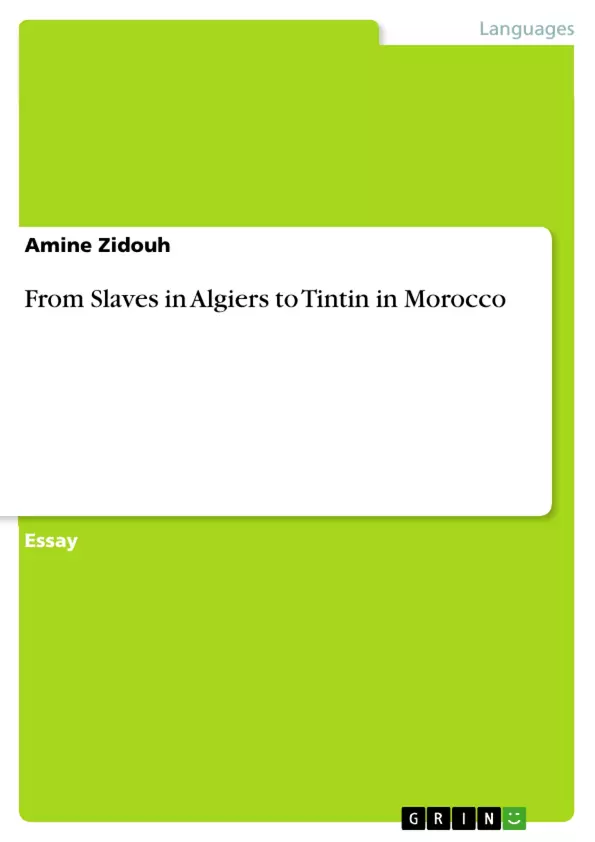This essay is a comparative study between two genres, two ‘texts’, two discourses that are really just the same. Although they are separated in time, space and form, both ‘texts’ end up disseminating the same derogatory discourse; that some would call colonial about the Maghreb in particular and the orient in general. Slaves in Algiers; Or a Struggle for Freedom (1794), is a play written by Susanna Haswell Rowson, where the setting takes place in “Barbary” – the Mediterranean coast of North Africa – and more precisely in Algiers. The play centers on the lives of several American ‘slaves’ who plot their escape in an unflappable look for freedom. Whereas Tintin, you would have guessed is the famous Comic hero created by Belgian ‘artist’ Hergé. The movie that this essay analyzes is entitled “The Adventures of Tintin” (2011) and is directed by yet another ‘artist’ considered to be one of the all-time best directors in American Cinema; Steven Spielberg. At first sight, the 3D movie seems not to have much in common with a play written in the 18th century, yet this essay claims otherwise.
Inhaltsverzeichnis (Table of Contents)
- Introduction
- From Slaves to Tintin: A Comparative Analysis
- Slaves in Algiers: A Play by Susanna Haswell Rowson
- Tintin in Morocco: A 3D Movie by Steven Spielberg
- The Stereotypical Images
- The Impact of Cinematic Discourse
Zielsetzung und Themenschwerpunkte (Objectives and Key Themes)
This essay aims to conduct a comparative study between two genres, two "texts," two discourses that ultimately convey the same derogatory message about the Maghreb and the Orient. The essay analyzes how both "texts," separated by time, space, and form, perpetuate colonial discourse.- The portrayal of the Maghreb and the Orient in Western media
- The perpetuation of colonial stereotypes through different forms of discourse
- The influence of Hollywood in shaping perceptions of Arab and Moroccan cultures
- The dangerous impact of stereotypical representations on young audiences
- The comparison between historical and contemporary portrayals of the Maghreb
Zusammenfassung der Kapitel (Chapter Summaries)
This preview focuses on the main themes, arguments, or narrative elements of each chapter. The conclusion, final chapter, or any sections containing major revelations or spoilers are excluded.- Introduction: This chapter introduces the subject matter and outlines the essay's comparative approach, highlighting the similarities between two seemingly disparate texts. It establishes the core argument that both texts reinforce derogatory discourse about the Maghreb and the Orient.
- From Slaves to Tintin: A Comparative Analysis: This chapter delves into the specific examples of "Slaves in Algiers" by Susanna Haswell Rowson and "The Adventures of Tintin" by Steven Spielberg. It analyzes how both texts perpetuate colonial stereotypes, despite being separated by time, space, and genre.
- The Stereotypical Images: This chapter examines the specific stereotypical images used in both texts, focusing on the portrayal of Arabs, North Africans, Muslims, and Moroccans. It highlights the similarities in the representation of women and characters within these texts.
- The Impact of Cinematic Discourse: This chapter explores the broader impact of cinematic discourse in shaping perceptions of Arab and Moroccan cultures. It draws on the work of Jack Shaheen and William Greider to illustrate the influence of Hollywood in perpetuating stereotypical representations.
Schlüsselwörter (Keywords)
The primary focus of this work is the portrayal of the Maghreb and the Orient in Western media. This involves a comprehensive analysis of colonial discourse, stereotypical representations of Arab and Moroccan cultures, the influence of Hollywood, and the dangerous impact of such representations on young audiences. Key concepts include "colonial discourse," "Orientalism," "stereotypes," "Hollywood," and "cinematic discourse."- Citar trabajo
- Student-Researcher Amine Zidouh (Autor), 2013, From Slaves in Algiers to Tintin in Morocco, Múnich, GRIN Verlag, https://www.grin.com/document/212045



